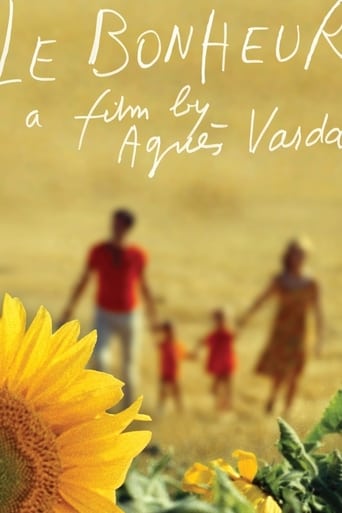

Le Bonheur is, in my opinion, one of Varda's most underrated films, partially due to the fact that it was not distributed in the USA until the 1990s. Another reason is that Le Bonheur potentially contradicts --or at least complicates -- Varda's legacy as a feminist New Wave filmmaker. This film is about the human condition... a condition as elusive as the film's underlying message. One of the most unique features of Le Bonheur is its ability to implicate the viewer into the interpretation of the film. In other words, how you react to this film depends on your own, pre-determined values and morals. Varda's narrative is open-ended enough to allow for a variety of interpretations. Even the film's lyrical and poetic treatment of the story could be interpreted as either an act of bitter cynicism, or as a matter-of-fact statement about the cyclical nature of life.
... View MoreThis movie is rich! One of the richest out of the thousands I've seen. I had to pause it after every scene just to catch my breath and to digest the images and emotions that came from the screen. It is less like watching a movie and more like going to a painting exhibit of newly discovered Renoirs and Monets. The beauty and the music simply got my heart thumping, and then, all I can say is that the plot seems to emerge out of the art direction. Genius! It is impossible for me to free my mind now from the images, which are startlingly fresh, in the way that "Letyat zhuravli" (The Cranes are Flying) was in 1957, or the opening shot of "Cleo de 5 a 7" was in 1962. The composition of every shot is immaculately precise in the manner of Jacques Tati's "Monsieur Hulot" movies, or Godard's "Une femme mariee" (1964) or the magazine industry, but Agnes Varda's movie is greater than all of these, because whereas those are static, motionless, almost feeling-less projects, hers has somehow managed to come across fluidly, effortlessly, vividly as anything before or after until the works of Kieslowski. It felt like I was watching a scene out of some family's life in heaven, and then, one of the children looks at the camera and offers some fruit, as if Varda is winking at us and saying, "Enjoy, come in. Be a part of our wonderful time." Can life really be so wonderful as it is in this movie? The movie goes on to probe that very question. And I am better for it.
... View MoreWatching this film the last time, some 45 years ago, upon it's original UK release, I was blown away. I felt I had never seen such beautiful sunny summer images, I was astonished at the use of posters and advertising hoardings for composition. I notice now that some of these aspects have coloured my own photographic sensitivities. I remember the film as one long celebration of happiness and the suggestion that with the right attitude life would be like this. Seeing it again, it is still undoubtedly beautiful and I possibly appreciate even more the wonderful cinematography, however, now I notice how subversive this movie is. I have a feeling that this is very much a personal film seen through Varda's eyes and she is suggesting that a woman might easily do as the second woman does in this without causing so much as a head to turn. I think not, this is fantasy. The guy is unreal, men don't lie around saying how happy they are all the time, never mind the way he fails to be affected by the incident. I imagine at the time I saw this as a depiction of a real possibility. I seem to remember thinking lots of things were possible in the 60s that have turned out not to be. Nevertheless, this is still a beautiful movie,
... View MoreThere's something dreamlike about the way the main male character of this film drifts through it. And it is a treat to look at. Both his wife and his mistress are beautiful, as is some of the scenery. Note the extraordinary way Varda uses colour to distinguish the female characters, the clothes of wife sunflower yellow, of the mistress cornflower blue. That colour coding extends to the places around them. The only film I have seen with an even remotely similar colour sense is "Les Parapluies de Cherbourg" by Jacques Demy, Varda's husband. Le Bonheur never gives us a clear guide to what the main characters really fee. They live on the surface of their emotions but as an aesthetic experience the film is outstanding.
... View More